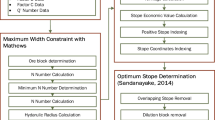Abstract
This paper presents a probabilistic approach for optimizing stope design methodology while taking into consideration the variability in the rock mass properties. For this study, a complex orebody in a Canadian mine was used. Because of the variability in the rock mass properties of the orebody, it was not possible to determine precisely, the values of geotechnical design input parameters and hence the need to utilize a probabilistic approach. Point Estimate Method (PEM), a probabilistic tool, was incorporated into numerical analysis using FLAC3D to study the deformation magnitudes of various stope geometries to determine the optimal stope geometry with a minimum ground control problem. Results obtained for the distribution of the wall deformations and the floor heaves for each option of the stope geometry were compared to select the best geometry to achieve the optimum stability condition. The methodology presented in this study can be helpful in the process of underground mine planning and optimization in complex orebody.
Similar content being viewed by others
References
Cai, M., Rock Mass Characterization and Rock Property Variability Considerations for Tunnel and Cavern Design, Rock Mech. and Rock Eng., 2011, vol. 44, no. 4, pp. 379–399.
Idris, M.A., Saiang, D., and Nordlund, E., Numerical Analyses of the Effects of Rock Mass Property Cariability on Open Stope Stability, Proc. of the 45th US Rock Mechanics/GeomechanicsSymp., San Francisco, Ca. 2011.
Idris, M.A., Saiang, D., and Nordlund, E., Probabilistic Analysis of Open Stope Stability Using Numerical Modelling, Int. J. Min. and Mineral Eng., 2011, vol. 3, no. 4, pp. 194–219.
Valley, B., Kaiser, P.K., and Duff, D., Consideration of Uncertainty in Modellng the Behavior of Underground Excavations, Proc. of the 5th Int. Seminar on Deep and High Stress Min., Santiago, Chile, 2010.
Idris, M.A., Nordlund, E., and Saiang, D., Comparison of Different Probabilistic Methods for Analyzing Stability of Underground Rock Excavations, The Electronic J. of Geotech. Eng., 2016, vol. 21, no. 21, pp. 6555–6585.
FLAC3D (Version 4.0) Computer software, Minneapolis, Minnesota: Itasca Consulting Group, Inc.
Marinos, P. and Hoek, E., A Geologically Friendly Tool for Rock Mass Strength Estimation, Proc. of the GeoEng 2000 Conf., Melbourne, Australia, 2000.
Hoek, E., Carranza-Torres, C.T., and Corkum, B., Hoek-Brown Failure Criterion-2002 Edition, Proc. of the 5th North American Rock Mechanics Symp., Toronto, ON, 2002.
@RISK, Risk Analysis Software Using Monte Carlo Simulation for Microsoft Excel and Microsoft Project. Available at: https://www.palisade.com/msoffice/risk.asp.
Rosenblueth, E., Two-Point Estimates in Probabilities, Appl. Math. Modelling, 1981, vol. 5, no. 5, pp. 329–335.
AbdellahMitri, H.S., Thibodeau, D., and Moreau-Verlaan, L., Geotechnical Risk Assessment of Mine Development Intersections with Respect to Mining Sequence, Geotech. and Geol. Eng., 2014, vol. 32, no. 3, pp. 657–671.
Hoek, E., Reliability of Hoek-Brown Estimates of Rock Mass Properties and Their Impact on Design, Int. J. Rock Mech. and Min. Sci., 1998, vol. 35, no. 1, pp. 63–68.
Langford, J.C. and Diederichs, M.S., Reliability Based Approach to Tunnel Lining Design Using a Modified Point Estimate Method, Int. J. Rock Mech. and Min. Sci., 2013, vol. 60, pp. 263–276.
Park, D., Kim, H.M., Ryu, D.W., Choi, B.H., and Han, K.C., Probability-Based Structural Design of Lined Rock Caverns to Resist High Internal Gas Pressure, Eng. Geol., 2013, vol. 153, pp. 144–151.
Park, D., Kim, H.M., Ryu, D.W., Song, W.K., and Sunwoo, C., Application of a Point Estimate Method to the Probabilistic Limit-State Design of Underground Structures, Int. J. Rock Mech. and Min. Sci., 2012, vol. 51, pp. 97–104.
Napa-García, G.F., Beck, A.T., and Celestino, T.B., Reliability Analyses of Underground Openings with the Point Estimate Method, Tunneling and Underground Space Technology, 2017, vol. 64, pp. 154–163.
Arjang, B., and Herget, G., In Situ Ground Stresses in the Canadian Hard Rock Mines: An Update, Int. J. Rock Mech. and Min. Sci., 1997, vol. 34, nos. 3–4, pp. 15.e1–15.e16.
Herget, G., Stress Assumptions for Underground Excavations in the Canadian Shield, Int. J. Rock Mech., Min. Sci. &Geomech. Abstract, 1987, vol. 24, pp. 95–97.
Diederichs, M.S., Instability of Hard Rock Masses: The Role of Tensile Damage and Relaxation, Waterloo, ON, University of Waterloo, 1999.
Milne, D.M., Underground Design and Deformation Based on Surface Geometry, British Columbia, University of British Columbia, BC, 1997.
Sakurai, S., Strength Parameters of Rocks Determined from Back Analysis of Measured Displacements, Proc. of the First Asian Rock Mech. Symp., Seoul, South Korea, 1997.
Huebscher, R.G., Friction Equivalents for Round Square and Rectangular Ducts, ASHVE Transactions, 1948, vol. 54, pp. 101–118.
Ang, A.H-S. and Tang, W.H., Probability Concepts in Engineering, John Wiley & Sons, Inc., USA, 2007.
Funding
This study was financially supported by the Center for Advanced Mining and Metallurgy (CAMM) at the Luleå University of Technology, Luleå, Sweden.
Author information
Authors and Affiliations
Corresponding author
Additional information
Published in Fiziko-Tekhnicheskie Problemy Razrabotki Poleznykh Iskopaemykh, 2019, No. 5, pp. 56–62.
Rights and permissions
About this article
Cite this article
Idris, M.A., Nordlund, E. Probabilistic-Based Stope Design Methodology for Complex Ore Body with Rock Mass Property Variability. J Min Sci 55, 743–750 (2019). https://doi.org/10.1134/S1062739119056112
Received:
Revised:
Accepted:
Published:
Issue Date:
DOI: https://doi.org/10.1134/S1062739119056112




